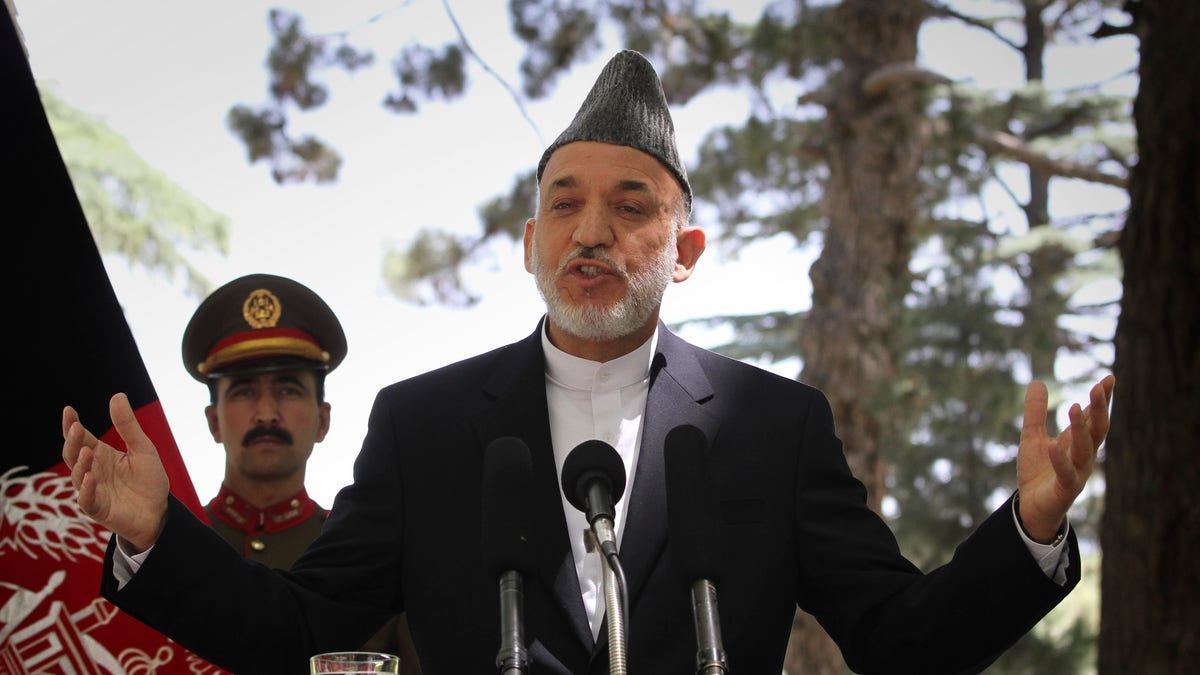
May 31: Afghan President Hamid Karzai gestures during a press conference at the presidential palace in Kabul, Afghanistan. Angered by civilian casualties, Karzai said Tuesday he will no longer allow NATO airstrikes on houses, issuing his strongest statement yet against strikes that the military alliance says are key to its war on Taliban insurgents. (AP) (AP2011)
When an errant NATO bombing raid left nine Afghans, women and children among them, dead in southern Helmand province over the weekend, President Hamid Karzai issued a stark warning to NATO.
“They must treat Afghanistan as a sovereign nation,” Karzai said. “Sometimes we have statements from them that reflects as if they are not aware that they are working in a sovereign nation."
The Afghan president demanded NATO stop acting like an “occupier,” or he added, “the Afghan government will be forced to take a unilateral action in this regard."
Some see this as an empty threat given that last year the U.S. spent $1.3 billion rebuilding Helmand province whose population is 80,000. That’s about the same amount of foreign aid as the U.S. State Department gives annually to Egypt's 80 million people.
Karzai’s criticisms come as lawmakers in Washington continue to argue over whether or not President Obama’s nation building strategy is worth the cost at a time of deep deficits here at home.
All told, the U.S. taxpayer has spent nearly $1 trillion on the wars in Afghanistan and Iraq since September 11, 2001. As of March 31 of this year, the Defense Department estimates it has spent $993.5 billion for all war related costs. And it continues to spend $5.6 billion a month in Afghanistan alone.
The cost to keep U.S. troops in combat in Afghanistan is nearly $1 million per service member each year.
And the single largest line item in the FY 2012 defense budget is $13 billion to train and equip the Afghan military, most of whom are illiterate. The U.S. has already spent $28 billion to train Afghan security forces with the hope of eventually transitioning control to them, according to Defense Department figures.
The White House pushed back on the notion that cost would dictate how fast President Obama draws down troops in Afghanistan, a process that is supposed to begin in July. Just as it had not influenced the president's decision to send 30,000 surge troops in 2009, White House spokesman Jay Carney said.
“He didn’t ask for a bill for how much it would cost,” Carney said. “He wanted a policy that had the best chance of succeeding at achieving our goals which were very clearly defined to disrupt, dismantle and ultimately defeat Al Qaeda and to insure that Afghanistan would not again be a haven for terrorists.”
Experts, such as the Brookings Institution’s Michael O’Hanlon, who just returned from Afghanistan, agree.
“I actually don’t think money will be a big concern. I've done some simple calculations that suggest the price tag of this war, while it's huge, it's not going to change that much even if you try to accelerate the draw down a bit,” O’Hanlon says. “And if you were to do that, the chances of defeat go up quite a bit.”
Military planners estimate the Afghanistan War will cost about $700 billion when it winds down in 2014, as the president has promised. O'Hanlon says it will still cost U.S. taxpayers about $600 billion even with an accelerated pullout.
That’s because an accelerated pullout doesn’t necessarily mean taxpayers will pay less in the end. Even if the U.S. is able to pull out 100,000 or so troops quickly, elite counter terrorism forces will remain in the country.
“If you start pulling out and doing what people call ‘counter terrorism plus,’ and you start moving to that by, let's say, the fall of this year maybe you cut the 2012 budget almost in half.” But, O’Hanlon adds, the Pentagon could then find itself spending $20 to $30 billion a year indefinitely.
